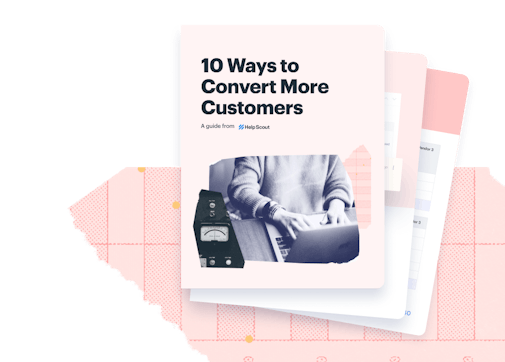As more and more products come into existence, differentiating one from another becomes even more challenging. In a sea of competitor names, it may be difficult for a customer to pick your product out from the group. One of the best ways that companies can differentiate themselves isn't through building shinier, fancier product features — it's through their customer engagement strategy.
What is a customer engagement strategy?
A customer engagement strategy is the documented process through which every customer-touching team within your company engages with your users and customers. For most businesses, it encompasses every customer touchpoint from when they first come to your marketing site or social media channels all the way through until they churn.
Creating your strategy should include any team that engages with your customers: marketing, sales, support, customer success, and even product team members should all be involved. The goal of your strategy should be to build better relationships, boost satisfaction, and — ultimately — support and grow your customer base.
Many companies choose first to take stock of all of their customer touchpoints and then arrange them in a journey map for better visualization. Journey mapping enables team members to visualize every point of contact, understand redundancies and bottlenecks, and begin to identify measurements for success.
Ways to track customer engagement
Companies use several key metrics to understand whether or not customers are engaged with their products. Your company may already be tracking many of these, but it might not tie them directly to your customers' engagement patterns:
NPS: Net Promoter Score is a survey companies send out asking how likely a user or customer is to recommend a product to their friends or family. A customer likely wouldn't promote your product if they weren't well-engaged.
CSAT: Customer satisfaction score is a survey you send to customers after they have had an interaction with a customer-facing team. You may also send it after a meaningful interaction with your product, such as adding users or implementing a key feature. This survey asks how satisfied the customer was with their experience.
CES: Companies send customer effort score surveys with the same cadence as CSAT surveys, but instead of measuring satisfaction, they ask the customer about how easy it was to find the solution/option/service that they were looking for.
Product adoption score: Product adoption score is usually a proprietary score that a company creates to calculate how much of their product a customer is using. This score should be compiled collaboratively with the product team by making a list of critical features, weighing their perceived "stickiness" for the customer, and then creating an algorithmic score.
Customer health score: Customer health score is similar to product adoption score but typically also considers actions like reaching out to your support team, leaving an NPS response, and other activities. To create this proprietary score for your business, you'd consider product adoption score and any other key indicators that show a customer is healthy.
Churn rate: Churn rate is specific to subscription-based business models and refers to the number of customers who renew their subscriptions versus those who leave to go to a competitor.
LTV: Lifetime value is the average value that a customer has for a company over their lifetime as a user. The more a customer buys, the higher their lifetime value will be. When customers engage with your product, they have a higher LTV.
Session time: Session time is a metric that tracks how long customers spend on your site, while logged in.
Bounce rate: Bounce rate is a metric that measures how many users come to your website, view a single page, and then leave and never return.
Companies can interpret each of these as one more data point in understanding how engaged their customers are and how likely they are to be more deeply engaged in the future. They also let you know how successful (or unsuccessful) your current efforts are at boosting customer engagement.
The benefits of customer engagement strategies
As humans, we are genetically programmed to build relationships, and it feels good to connect on a deeper level with others. Outside of the "feel good" benefits of engaging and connecting, though, there are plenty of business and fiscal benefits in trying to boost your customer engagement strategy.
Competitive advantage
When several businesses all offer very similar feature sets and benefits, a key differentiating factor is how they treat their customers. When you provide an excellent customer experience and a groundbreaking engagement strategy, it helps convert users in the evaluation phase for your product.
Boosts LTV
Lifetime value is a significant financial metric for many businesses. The more engaged your customers are, the more likely they will continue expanding their use of your product. Those customers with intense product usage are primed to be your beta testers and early adopters — and to have a high LTV.
More referrals
Word of mouth marketing is one of the most potent ways for businesses to get additional reach from their traditional marketing efforts. When you regularly engage with your customers to remind them that your product exists and name of all of its great benefits, you set your company constantly at the top of their minds.
Better product adoption
When you have a customized journey that you walk customers through, you can control (to some extent) which features they set up in which order. That control ensures that you help your users optimize for the best possible experience for their needs. Showcasing the best features at the right times can feel magical for your customers, and it makes it easy for them to use your product without much thought or effort.
Improved customer trust
Trust is one of the critical elements of a healthy relationship, and that is no different when it comes to relationships with your customers. As you make more effort to provide helpful engagement to your customers, the focus on what you're trying to educate them about becomes less about what they can do for you and instead what your product will offer to them. As the focus shifts, so does the customer's trust.
How to increase customer engagement
Once you understand how to track and measure your customer engagement, it's time to start focusing on how to improve it. There are several ways that different organizations within your business can work to implement customer engagement best practices. The approaches will differ depending on which organization is spearheading the effort, but all of them will improve your engagement.
Set a goal for successful customer engagement
Now that you understand how you are currently performing, it's a great time to set a goal for how you'd like to perform in the future. Work collaboratively across your cross-functional teams to understand where things need to improve, and start setting goals to move toward them.
For instance, your marketing team may notice that the bounce rate on your blog is high. To work collaboratively toward improving your customer engagement, they should focus on improving that while other teams may focus on metrics like customer satisfaction or churn rate. Set goals that make sense, and allow each team to work together and create a more significant holistic improvement.
Improve your overall customer experience
When you strive to improve the smaller experiences within your customer journey — like when the customer buys your product or reaches out for support — it makes it much easier for them to feel engaged. After all, each moment that breaks trust also breaks engagement. So, of course, each moment that feels good only draws your customers closer in.
When you align metrics like customer satisfaction and NPS with the specific points in your customer journey, it helps you understand where you may be losing engagement. Remember that a user who leaves a detractor score is likely less engaged than a promoter. Use that data to know where your company may be dropping the ball with your experience and to improve those efforts.
Boost the quality of your customer relationships
How often does your team reach out personally to a customer versus use an automated email? Personal connection from your team members to customers can be significant if done well.
For instance, take the time for a human to review every survey response that gets sent through. If there is a qualitative comment, either constructive or positive, reach out to the customer to thank them and let them know what you'll do with that feedback. While it may feel time-consuming, it is a great way to let customers know that you care.
Increase the likelihood of referrals
Customers who come to you with context are much easier to engage than ones who don't understand your value. If one of your customers has referred a friend by talking about your product's excellence, they are predisposed to believe it's fantastic.
By increasing your number of referrals, you stack the number of already excited and engaged customers from the start. Referrals can boost your customer engagement numbers and free up your team to spend energy increasing engagement elsewhere.
Begin cross-functional team collaboration
Customer engagement isn't something that happens in a silo, and it isn't something that your customer support or success teams should work on alone. For your customer engagement programs to be effective, everyone at the company needs to be invested and concerned with their outcomes.
If you haven't already, create a cross-functional cohort that works together to represent each team's stake within your customer engagement strategy. Cultivating ownership helps ensure that every team feels invested and works in lockstep with each other. Your marketing team should know what your support team is doing, for instance, and vice versa. When every team is rowing in the same direction, your efforts will go further.
Build a brand voice
Your customers can't engage with you if there is nothing to engage with. If your brand's voice is bland and undefined, you'll likely find that you don't have many customers wanting to engage with you.
Your marketing team should work to define a tone that represents your brand and the product that you offer. Start by understanding what types of personalities or voices your customers would best respond to. Then, create a style guide encompassing those standards so that everyone at the company can be aligned.
Share your brand voice online
Don't stop short by just using your brand voice on your marketing site and blog. Start using it more casually on social media, too. The more public you can be about establishing your product voice and values, the more likely it is you will attract new customers based on that voice.
Make social media posts that represent the tone of your brand, and allow them to be shareable by customers who feel specifically called to do so. This will expand your reach to readers who might not otherwise see your content.
Design your content around your customers' interests and concerns
Customers are more likely to engage with the things that they care about. If you create content around something that seems valuable to your company but doesn't matter to your customers, you will likely see less engagement.
Take the time to understand what your customers care about and what motivates them to use your product. With that information, create content, guides, and documentation that move them closer to their goals — focus on them rather than what you're trying to push as a company to make them want to continue reading and engaging with what you're creating.
Customer engagement best practices help everyone
Engaged customers are paramount to the success of your business in many ways. Being intentional about the ways you interact and the engagement strategies you choose can affect your bottom line, so it’s not something to take lightly.
Creating a customer engagement strategy is a process. Take your time, do your research, and update when necessary. When you’re engaged with your customers, chances are they’ll be engaged with you, too.









